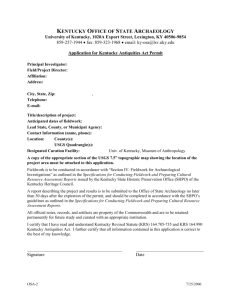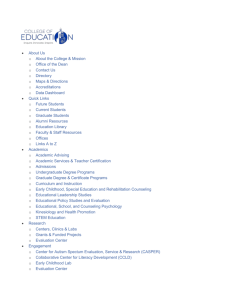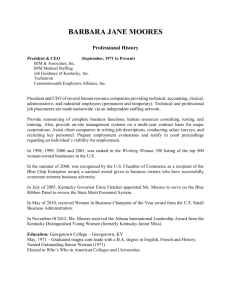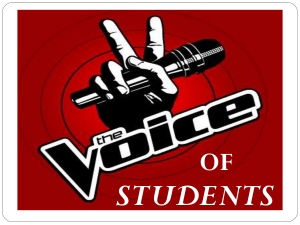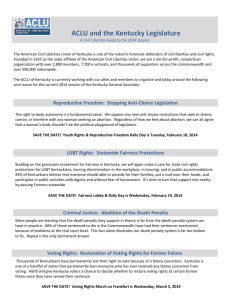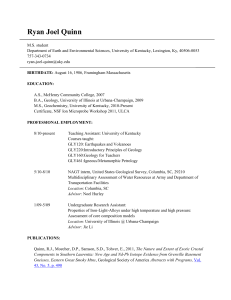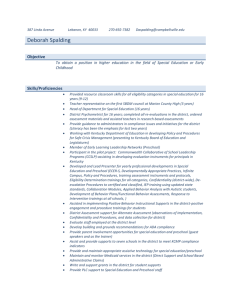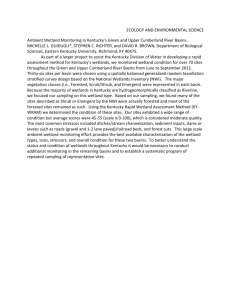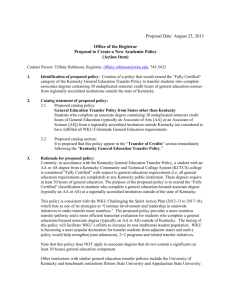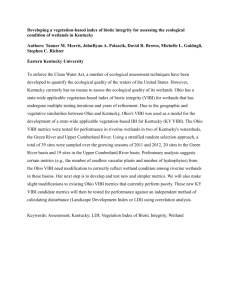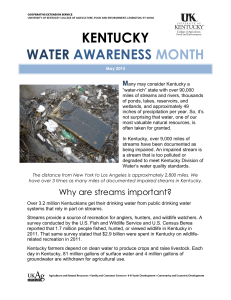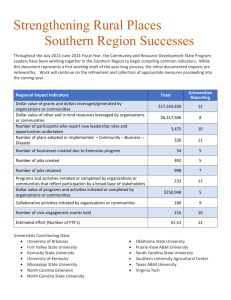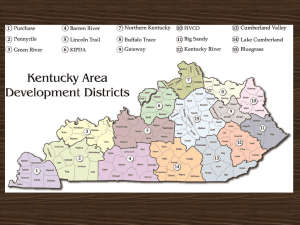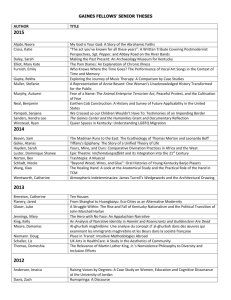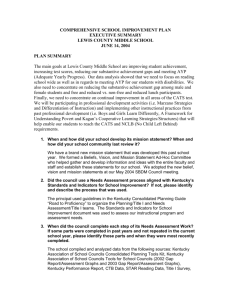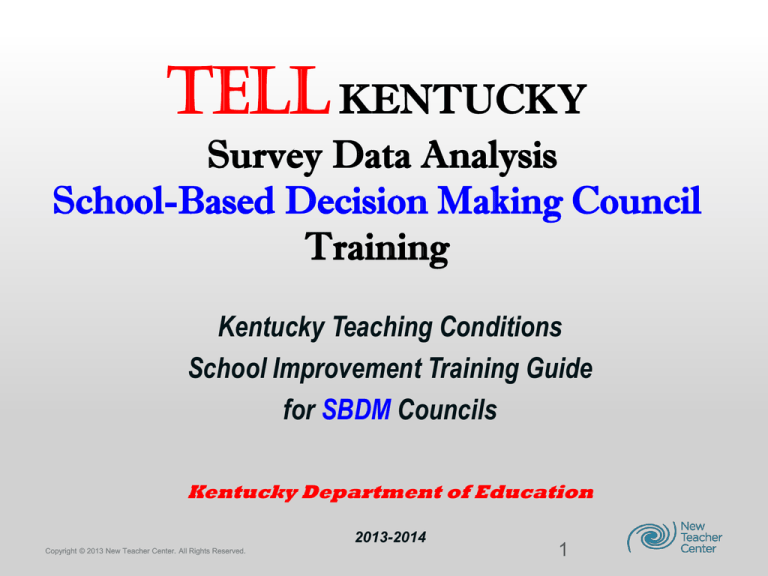
TELL KENTUCKY
Survey Data Analysis
School-Based Decision Making Council
Training
Kentucky Teaching Conditions
School Improvement Training Guide
for SBDM Councils
Kentucky Department of Education
2013-2014
Copyright © 2013 New Teacher Center. All Rights Reserved.
1
TELL KY Survey Data Analysis
School-Based Decision Making Council
Training
Insert
CCR
Logo
Here
Kentucky
Teaching Conditions
School Improvement Training Guide
for
SBDM Councils
This SBDM training material was developed by the Kentucky Department of Education (KDE), the Kentucky Education
Association (KEA), New Teacher Center and the Kentucky Association of School Councils (KASC).
Copyright © 2013 New Teacher Center. All Rights Reserved.
TELL
KENTUCKY
TEACHING, EMPOWERING, LEADING
AND LEARNING
This training references results from the 2013 TELL Kentucky
Survey available online at www.tellkentucky.org.
The intent is to begin discussion among staff on whether certain
teaching conditions are present in their school and to ensure data is
used in school improvement planning.
Copyright © 2013 New Teacher Center. All Rights Reserved.
3
TELL Kentucky Home Page
View 2013
Results
Copyright © 2013 New Teacher Center. All Rights Reserved.
4
State Results Icons
# Educators
# Completed
% Completed
District
Results Icons
Copyright © 2013 New Teacher Center. All Rights Reserved.
Find your District and School
Copyright © 2013 New Teacher Center. All Rights Reserved.
6
Basic TELL Vocabulary
• TELL – Teaching, Empowering, Leading and Learning
• Teaching and Learning Conditions – the systems,
relationships, resources, environments and people in your
school that affect your ability to teach (or learn) at a high level.
• Construct – a grouping of several specific questions, all dealing
with the same topic
**Time
**Teacher Leadership
**Facilities and Resources
**School Leadership
**Community Support & Involvement **Professional Development
**Managing Student Conduct
**Instructional Practices & Support
• Item – a specific individual question.
Copyright © 2013 New Teacher Center. All Rights Reserved.
7
Training Objectives
• Become familiar with your school’s data from the
2013 survey results and the TELL website.
• Understand the drill-down process in order to
analyze the data.
• Be able to unpack, disseminate and discuss
teaching conditions data to create action items in a
planning process for school improvement.
• Identify school council policies that may require
revision.
Copyright © 2013 New Teacher Center. All Rights Reserved.
8
Agenda
• Connecting to the Data
• Setting the Context
• Drilling Down into the Data
• Understanding the Constructs
• Examining Items
• Analyzing and Discussing a Specific Item
• Creating an Action Plan
Copyright © 2013 New Teacher Center. All Rights Reserved.
9
What We Know about Teaching
Conditions
•It matters for KIDS!!
•It matters for teacher retention.
•Principals and teachers view teaching
conditions differently.
Copyright © 2013 New Teacher Center. All Rights Reserved.
10
Uses of the Data
• as a baseline for improvement
• as a way to measure improvement
• as a way to help us prioritize our needs to inform
our school improvement plan
Copyright © 2013 New Teacher Center. All Rights Reserved.
11
Three icons to access the results for
the state, districts and schools
Copyright © 2013 New Teacher Center. All Rights Reserved.
Summary Report
COUNTY
COUNTY
NAME
School
name
School name
Copyright © 2013 New Teacher Center. All Rights Reserved.
13
Summary Report –
Finding your School Data
Need new screen
shot here
59.9
Copyright © 2013 New Teacher Center. All Rights Reserved.
14
Connector Directions
1. Read the rating system.
2. Reflect upon each Teaching Condition Construct
and rate them from 1-4.
3. Reflect and write a few notes about each
Teaching Conditions Construct.
4. Find a partner and share out key points for two
minutes each.
Copyright © 2013 New Teacher Center. All Rights Reserved.
15
Connector
Copyright © 2013 New Teacher Center. All Rights Reserved.
16
Construct Definitions
• Time: Available time to plan, collaborate and provide instruction and barriers to maximizing
time during the school day.
• Facilities and Resources: Availability of instructional, technology, office, communication
and school resources to teachers.
• Community Support and Involvement: Community and parent/guardian communication
and influence in the school.
• Managing Student Conduct: Policies and practices to address student conduct issues and
ensure a safe school environment.
• Teacher Leadership: Teacher involvement in decisions that impact classroom and school
practices.
• School Leadership: The ability of school leadership to create trusting, supportive
environments and address teacher concerns.
• Professional Development: Availability and quality of learning opportunities for educators
to enhance their teaching.
• Instructional Practices and Support: Data and supports available to teachers to improve
instruction and student learning.
Copyright © 2013 New Teacher Center. All Rights Reserved.
17
Prioritize the Constructs
• Prioritize the Constructs on your own.
• Compare your list with your table group.
• Together, decide upon a common list.
• Highlight your greatest NEED(s).
Copyright © 2013 New Teacher Center. All Rights Reserved.
18
Areas of Concern
Construct
Item
Copyright © 2013 New Teacher Center. All Rights Reserved.
Causes / Reasons
Strategies for
Improvement
19
Data Drill Down Process
Examine the Construct Indicators
Determine a Construct of Focus
Examine Items Within the
Construct
Determine an Item
of Focus
Analyze
Individual
Items
Develop
Plan
Copyright © 2013 New Teacher Center. All Rights Reserved.
20
Choose an Item of interest
Narrow your focus even further by
prioritizing your Items for this
Construct.
• Your item of focus does NOT have to be your lowest
item scores.
• You and your faculty know the context of your school.
Use that knowledge to choose an item of greatest
impact to explore further.
Copyright © 2013 New Teacher Center. All Rights Reserved.
21
Summary Report
2013
Copyright © 2013 New Teacher Center. All Rights Reserved.
Item Findings
• Are there any patterns?
• Which Items are most populated?
• Which Items can we rule out?
• What does this tell us about our current needs?
Copyright © 2013 New Teacher Center. All Rights Reserved.
23
Process for Analyzing an
Identified Item
What is
working?
What is not
working?
Copyright © 2013 New Teacher Center. All Rights Reserved.
What are
challenges
to achieving
the ideal?
What would
be ideal?
24
What’s Working? What’s Not?
Copyright © 2013 New Teacher Center. All Rights Reserved.
25
Fill in your own “What’s Working”
Copyright © 2013 New Teacher Center. All Rights Reserved.
26
Ideal Example
Copyright © 2013 New Teacher Center. All Rights Reserved.
27
Where are we Going?
Copyright © 2013 New Teacher Center. All Rights Reserved.
28
Graffiti Wall Ideals
DIRECTIONS:
Record 3 or 4 Challenges to the Ideal.
Brainstorm as many ways to overcome those challenges as possible.
CHALLENGE #1
___________
CHALLENGE
#2
CHALLENGE # 3
Ways to Overcome
Ways to Overcome
Ways to Overcome
Copyright © 2013 New Teacher Center. All Rights Reserved.
29
How to Create an Action Plan
Copyright © 2013 New Teacher Center. All Rights Reserved.
30
Need Andrew to re-do this screen shot with new title:
Action Plan
Copyright © 2013 New Teacher Center. All Rights Reserved.
31
Need Andrew to re-do this screen shot
with new title:
Action Plan
Copyright © 2013 New Teacher Center. All Rights Reserved.
32
Copyright © 2013 New Teacher Center. All Rights Reserved.
33
Creating Objectives
• Come to consensus about a single objective by
combining dominant ideas.
• Place a Check by key nouns that are repeated:
Time, Planning, Meeting.
• Underline key verbs/adverbs that are repeated:
meet efficiently, listen carefully.
Copyright © 2013 New Teacher Center. All Rights Reserved.
34
Finish the Action Plan
• Fill in the assigned section of the Action Plan
with your table group.
• What must be included?
• How will we know we succeeded?
• What resources are needed?
• By Whom? / By When?
• Report out.
• Commit to the goal.
Copyright © 2013 New Teacher Center. All Rights Reserved.
35
Congratulations !! We DID IT !!
• This is only the beginning!!
• We’ve worked and identified an area for growth.
• We’ve made an action plan for HOW we’ll
improve.
• Now we have to DO it.
Copyright © 2013 New Teacher Center. All Rights Reserved.
36
Thank you for your time.
Questions?
Copyright © 2013 New Teacher Center. All Rights Reserved.
37



